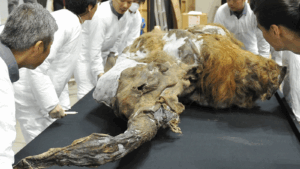Global warming encroaches on ice in North America’s Arctic Region
Summer sea ice, frozen seawater in the Arctic that floats over the ocean’s surface during the summer, currently covers less than half the area it spanned in the 1980s (1). Due to climate change, the area of summer sea ice is continuing to reduce rapidly (6). According to the National Snow and Ice Data center, the amount of ice that survives summer melting has shrunk by 13% per decade since 1981 (6). However, scientific projections have found that a one-million-square-kilometer region of ice north of Greenland and the coasts of the Canadian Arctic Archipelago could withstand melting amidst increasing temperatures (1). This area is known as the Last Ice Area and offers hope for the survival of arctic animals despite climate change.
The geographical location of the Last Ice Area allows it to be less impacted by climate change than other polar regions. The Last Ice Area is the size of the American West Coast (1). Home to many arctic species, the region is protected by the Arctic Archipelago, which physically blocks the ice from drifting south into higher temperatures (6). Additionally, sea ice formed in the winter gets pushed by dominant wind currents towards the Northern American Continent where the ice piles up and thickens, a recurring process called transpolar drift, where Ice from Siberia drifts into the Last Ice Area (1). The Last Ice Area is the only sector of the Arctic where thick, old ice can still be found (7).
Although high temperatures cause ice thickness and concentration to decrease, ice drift speed increases as one moves from Siberia to the Last Ice Area (2). In 2006, scientists conducted a major expedition to understand the impacts of climate change on the Arctic Ocean (8). The Tara Expedition research group tracked a polar sailboat that the research group locked in ice (8). Following arctic drift patterns, the sailboat drifted with the sea ice from northern Russia, across the Central Arctic Basin to Fram Strait (2). The drift took 1.2 years rather than the three years that scientists predicted based on climatological ice drift speed (2). This discovery portends endurance for the Last Ice Area, because winter ice formed in Siberia will drift faster towards the North American Continent, creating more ice layers (2). However, the ice forming is much thinner than in previous years because of higher temperatures, so it will melt faster and join sea waters (1). Thin ice is a problem for numerous species of marine life that live on the bottom of the ice similar to plankton and algal species (3). As the primary source of the food chain, plankton and algal species support the arctic ecosystem (3). Polar bears need sea ice to hunt, so the Last Ice Area could provide a refuge for them and other species (5). About a quarter of the polar bear population already live in or around the region’s Last Ice Area (5). Scientists hope that the Last Ice Area will be a sanctuary for arctic wildlife as global warming continues (3).

A computer model, released in September of last year by Science News, predicts that the Last Ice Area will maintain its summer sea ice if the emissions from fossil fuels do not warm the planet more than two degrees Celsius above pre-industrial levels, the goal set by the 2015 Paris climate treaty (3). Although this indicates that the Last Ice Area could protect arctic species, the region still faces threats from increasing global temperatures. An October United Nations report found that “new national climate pledges combined with other mitigation measures put the world on track for a global temperature rise of 2.7 degrees Celsius by the end of the century” (4). If all the ice in the Arctic melted, sea levels would rise to about 70 meters, covering all coastal cities and shrinking land area significantly (9).

In February 2018, a large stretch of ice-ringed open water, or a polynya, appeared in the Last Ice Area, which threatens the region that scientists predicted will remain at least until 2050 (1). We must take more steps against climate change in order to maintain Arctic ecosystems and our planet. Scientists hope that new technologies will be created to help capture greenhouse gasses, but in the meantime, the Last Ice Area may delay the extinction of species that rely on ice (3).
Bibliography:
- Krajick, Kevin. (2021, October 12). Arctic Sea Ice May Make a Last Stand in This Remote Region. It May Lose the Battle. Columbia Climate School. Retrieved from https://news.climate.columbia.edu/2021/10/12/arctic-sea-ice-may-make-a-last-stand-in-this-remote-region-it-may-lose-the-battle/.
- Pfirman, Stephanie. (2009). The Last Arctic Sea Ice Refuge. The Circle, Columbia University. Retrieved from https://web.law.columbia.edu/sites/default/files/microsites/climate-change/files/Arctic-Resources/Sea-Ice-Refuge/Pfirman%20article%20the%20circle.pdf
- Kreier, Freda. (2021, December 22). Can Scientists Develop an Icy Sanctuary for Arctic Life? Science News for Students. Retrieved from https://www.sciencenewsforstudents.org/article/arctic-last-ice-area-climate-change
- UNEP, DTU Partnership. (2021, October 26). Emissions Gap Report 2021. United Nations. Retrieved from https://www.unep.org/resources/emissions-gap-report-2021
- Frost, Mette. (2014, December 1). Protect the Artic’s Last Ice. WWF. Retrieved from https://arcticwwf.org/places/last-ice-area/
- Lindsey, Rebecca. Scott, Michon. (2020, September 8). Climate Change: Arctic Sea Ice Summer Minimum. National Oceanic and Atmospheric Administration. https://www.climate.gov/news-features/understanding-climate/climate-change-arctic-sea-ice-summer-minimum
- Colucci, Renato R. (2021, October 17). The Bery Last Thick Sea Ice of the Arctic Breaks while Severe Storms reach the Arctic, eventually supported by Sudden Stratospheric Warming. Severe Weather Europe. https://www.severe-weather.eu/cryosphere/thick-sea-ice-arctic-breaks-stratospheric-warmings-rrc/#:~:text=Here%20ice%20has%20persisted%20there,of%20Ellesmere%20Island%20and%20Greenland.
- Google Arts and Culture. (2007). Tara Arctic: A unique expedition on the top of the world. Google. https://artsandculture.google.com/exhibit/tara-arctic-a-unique-expedition-on-the-top-of-the-world/2QIC6MDq5LOMLQ
- Mathez, Edmund. Will the world ever be underwater because of all the ice melting? American Museum of Natural History. https://www.amnh.org/explore/ology/earth/ask-a-scientist-about-our-environment/will-the-world-ever-be-all-under-water#:~:text=If%20all%20the%20ice%20covering,such%20as%20Denver%2C%20would%20survive.






Comments are closed.